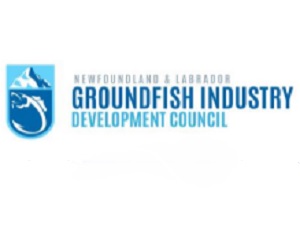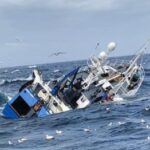Tag Archives: Gulf of St. Lawrence
Fishing industry watches tariff battle, counting the days till spring seasons
 Like everyone, Nova Scotia’s fishing industry has been trying to parse what U.S. President Donald Trump’s tariffs will mean for them. “It’s too early to know yet,” said Geoff Irvine, executive director of the Lobster Council of Canada. There is little lobster coming ashore right now, which buys the industry time to hope for a resolution that sees the 25 per cent tariff on all Canadian products heading south dropped. Fishing will pick up later this month off southwest Nova Scotia as waters warm, and then in April seasons will start opening from Newfoundland and Prince Edward Island to Nova Scotia, with massive quantities of crustaceans coming over wharves throughout the region by May 1. more, >>CLICK TO READ<< 06:29
Like everyone, Nova Scotia’s fishing industry has been trying to parse what U.S. President Donald Trump’s tariffs will mean for them. “It’s too early to know yet,” said Geoff Irvine, executive director of the Lobster Council of Canada. There is little lobster coming ashore right now, which buys the industry time to hope for a resolution that sees the 25 per cent tariff on all Canadian products heading south dropped. Fishing will pick up later this month off southwest Nova Scotia as waters warm, and then in April seasons will start opening from Newfoundland and Prince Edward Island to Nova Scotia, with massive quantities of crustaceans coming over wharves throughout the region by May 1. more, >>CLICK TO READ<< 06:29
Fishermen frustrated after DFO extends gulf herring moratorium by 2 years
 Scientists say there are no signs that the Atlantic herring stock is improving, but some fishermen aren’t convinced. Fisheries and Oceans Canada placed a moratorium on herring fishing in the Gulf of St. Lawrence in 2022, saying urgent action had to be taken to give the stocks a chance to recover. Three years later, DFO said that recovery hasn’t happened, prompting the agency to keep the fishery closed through 2026. “The stock status is currently very much like it was the past few years,” said Jacob Burbank, a research scientist with DFO. “The stock is still in the critical zone, and it has been in the critical zone since the early 2000s.” Video, more, >>CLICK TO READ<< 06:42
Scientists say there are no signs that the Atlantic herring stock is improving, but some fishermen aren’t convinced. Fisheries and Oceans Canada placed a moratorium on herring fishing in the Gulf of St. Lawrence in 2022, saying urgent action had to be taken to give the stocks a chance to recover. Three years later, DFO said that recovery hasn’t happened, prompting the agency to keep the fishery closed through 2026. “The stock status is currently very much like it was the past few years,” said Jacob Burbank, a research scientist with DFO. “The stock is still in the critical zone, and it has been in the critical zone since the early 2000s.” Video, more, >>CLICK TO READ<< 06:42
Snow crab quotas way up for some Cape Bretoners, way down for others
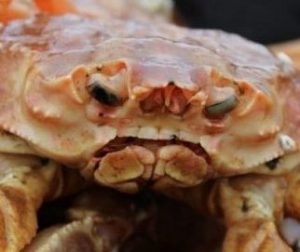 Gulf of St. Lawrence snow crab fishermen are learning who’ll be winners and losers when quotas are divided up for the 2025 season. At a meeting with Fisheries and Oceans Canada (DFO) in Moncton this week, the commercial fishermen in Area 19 (near shore in western Cape Breton) learned they’ll get a 42 per cent quota increase. That’ll offset quota cuts in the past two years that equaled about the same. The much larger Area 12 fishery, which covers the central Gulf of St. Lawrence all the way to New Brunswick, meanwhile, can expect to see an over 20 per cent cut to their quota. Demand for snow crab is high in the United States, where 85 per cent of what’s caught in the southern Gulf goes. Prices were around $4 a pound last year and it was hoped to be higher this season. But U.S. President Donald Trump’s threat of a 25 per cent tariff could hurt everyone’s bottom line. “We’re waiting on Trump, like every industry from forestry to mining,” said MacLean. more, >>CLICK TO READ<< 15:22
Gulf of St. Lawrence snow crab fishermen are learning who’ll be winners and losers when quotas are divided up for the 2025 season. At a meeting with Fisheries and Oceans Canada (DFO) in Moncton this week, the commercial fishermen in Area 19 (near shore in western Cape Breton) learned they’ll get a 42 per cent quota increase. That’ll offset quota cuts in the past two years that equaled about the same. The much larger Area 12 fishery, which covers the central Gulf of St. Lawrence all the way to New Brunswick, meanwhile, can expect to see an over 20 per cent cut to their quota. Demand for snow crab is high in the United States, where 85 per cent of what’s caught in the southern Gulf goes. Prices were around $4 a pound last year and it was hoped to be higher this season. But U.S. President Donald Trump’s threat of a 25 per cent tariff could hurt everyone’s bottom line. “We’re waiting on Trump, like every industry from forestry to mining,” said MacLean. more, >>CLICK TO READ<< 15:22
Gear tampering becoming more frequent in Gulf region, says DFO — and that means more ghost gear
 Gear tampering in the Gulf of St. Lawrence region off P.E.I. is more common than it used to be, according to the Department of Fisheries and Oceans, and the environmental cost can be high. “Gear tampering is any action that interferes or disrupts a legal fishery,” said Matthew MacEwen, the detachment supervisor in Charlottetown for Conservation Protection with Fisheries and Oceans Canada. “Examples of this could be tampering with traps, nets or lines… causing damage to that fishing gear that renders them incapable of doing their job fishing.” MacEwen said it could include cutting the ropes off traps, making them unretrievable, or bringing traps up from the waters and destroying the webbing and mesh that keep lobsters inside once they enter the traps. Video, photos, more, >>CLICK TO READ<< 06:26
Gear tampering in the Gulf of St. Lawrence region off P.E.I. is more common than it used to be, according to the Department of Fisheries and Oceans, and the environmental cost can be high. “Gear tampering is any action that interferes or disrupts a legal fishery,” said Matthew MacEwen, the detachment supervisor in Charlottetown for Conservation Protection with Fisheries and Oceans Canada. “Examples of this could be tampering with traps, nets or lines… causing damage to that fishing gear that renders them incapable of doing their job fishing.” MacEwen said it could include cutting the ropes off traps, making them unretrievable, or bringing traps up from the waters and destroying the webbing and mesh that keep lobsters inside once they enter the traps. Video, photos, more, >>CLICK TO READ<< 06:26

Call for Changes to Gulf of St. Lawrence Redfish Fishery Management, Inshore Fleet Demands Immediate Action
The 4R inshore fleet is calling on the Department of Fisheries and Oceans (DFO) to implement immediate changes to the management of the Gulf of St. Lawrence Unit 1 Redfish Fishery. Dozens of harvesters rallied outside the Barry Group plant in Curling today as members look to the federal government for urgent changes to access the small, time sensitive fishery. “DFO has not established harvest control rules that allow for a sustainable fishery for the 4R fleet, despite the critical importance of this resource to local communities,” explains Jason Spingle, FFAW-Unifor Secretary-Treasurer. “Minister Lebouthillier’s decision to allocate the majority of the fishery to the corporate dragger fleet has left the inshore fleet struggling to survive, and current rules mean they cannot access the small bit of quota do they have,” Spingle says. more, >>CLICK TO READ<< 14:09

‘More fat, more flavour’: Why PEI tuna is selling at its highest price in decades
“We’re seeing prices range from $10 or $11 on the low side to $40, $50, $60 a pound on the high side. So these are higher prices than we’ve seen, probably since the early 90s,” said Jason Tompkins, owner of TNT Tuna in North Lake, which buys and exports about three-quarters of Canada’s bluefin tuna quota. Tompkins says in a normal season, just “one or two” of the roughly 1,500 tuna caught off the northeast coast of P.E.I. will earn the boat more than $10,000, after being sold on high-end markets around North America, Europe and Japan. So far this year? photos, more, >>CLICK TO READ<< 06:50
Trawler-Crabber For Gulf Of St Lawrence
 Gaspé shipbuilder Chantier Naval Forillon is about to deliver a new trawler/crabber designed by Navanex for Pêcheries Michel Turbide. The new San Marco VII measures 23.99 metres and is built in steel with an aluminium superstructure. It is expected to fish for redfish in the Gulf of St Lawrence, alternating this with fishing for snow crab during the season, with crab traps handled over the starboard side. more, >>CLICK TO READ<< 08:49
Gaspé shipbuilder Chantier Naval Forillon is about to deliver a new trawler/crabber designed by Navanex for Pêcheries Michel Turbide. The new San Marco VII measures 23.99 metres and is built in steel with an aluminium superstructure. It is expected to fish for redfish in the Gulf of St Lawrence, alternating this with fishing for snow crab during the season, with crab traps handled over the starboard side. more, >>CLICK TO READ<< 08:49
P.E.I. student who’s worked on lobster boats seeking patent for new lifejacket
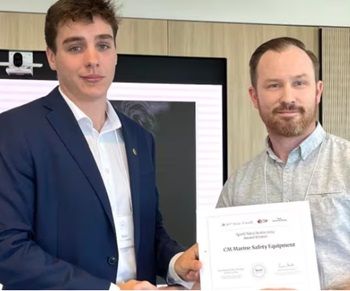 Ben Collings-MacKay is in fourth year at St. Francis Xavier University in Nova Scotia but hails from Montague in eastern P.E.I.. He has been spending most of his summers out on the Gulf of St. Lawrence, fishing lobster. But he is also the founder of CM Marine Safety Equipment, which in mid-June was awarded top prize for northern Nova Scotia in the annual Spark Nova Scotia competition meant “to activate early-stage innovation in rural parts of Nova Scotia.” Collings-MacKay knows first-hand the challenges fishermen face having to wear both an approved lifejacket or personal flotation device and the kind of protective gear that can keep them warm and dry as they handle heavy traps and nets in a physically demanding job. Video, more, >>CLICK TO READ<< 13:24
Ben Collings-MacKay is in fourth year at St. Francis Xavier University in Nova Scotia but hails from Montague in eastern P.E.I.. He has been spending most of his summers out on the Gulf of St. Lawrence, fishing lobster. But he is also the founder of CM Marine Safety Equipment, which in mid-June was awarded top prize for northern Nova Scotia in the annual Spark Nova Scotia competition meant “to activate early-stage innovation in rural parts of Nova Scotia.” Collings-MacKay knows first-hand the challenges fishermen face having to wear both an approved lifejacket or personal flotation device and the kind of protective gear that can keep them warm and dry as they handle heavy traps and nets in a physically demanding job. Video, more, >>CLICK TO READ<< 13:24
Gliders: Scientists add more underwater robots to monitor North Atlantic right whales
 In the race to protect the endangered species, researchers are bringing in more underwater robots—unmanned vehicles known as gliders that slowly patrol the Gulf of St. Lawrence, passively listening for whales. Gliders can stay at sea for months, move far offshore and work in all types of weather. They’re equipped with underwater microphones that scientists use to track the animals. The team added a third glider to its fleet this summer, expanding its ability to monitor whales’ whereabouts by sea and air. It’s collaborative effort involving researchers from University of New Brunswick, Ocean Tracking Network, Transport Canada and Woods Hole Oceanographic. more, >>CLICK TO READ<< 19:37
In the race to protect the endangered species, researchers are bringing in more underwater robots—unmanned vehicles known as gliders that slowly patrol the Gulf of St. Lawrence, passively listening for whales. Gliders can stay at sea for months, move far offshore and work in all types of weather. They’re equipped with underwater microphones that scientists use to track the animals. The team added a third glider to its fleet this summer, expanding its ability to monitor whales’ whereabouts by sea and air. It’s collaborative effort involving researchers from University of New Brunswick, Ocean Tracking Network, Transport Canada and Woods Hole Oceanographic. more, >>CLICK TO READ<< 19:37
Atlantic herring suffering in warming Gulf of St. Lawrence
 Decades of research show a slow decline in herring stocks in the Gulf of St. Lawrence, and scientists are linking that decline to waters that are warming with climate change. Recent research from NASA found that about 90 per cent of global warming is occurring in the ocean. In the Gulf of St. Lawrence, Joël Chassé, an oceanographer with Fisheries and Oceans Canada, said 11 of 12 months last year had warmer than normal surface temperatures, and he expects a similar pattern this year. “Fishermen in northern New Brunswick, the Baie des Chaleur region, were having difficulty finding the fish,” said Jacob Burbank, a researcher in fish ecology with Fisheries and Oceans Canada. “They weren’t seeing Atlantic herring where they normally would see Atlantic herring. They kept waiting for them to come in for their spawning and they just didn’t see them.” more, >>CLICK TO READ<< 11:40
Decades of research show a slow decline in herring stocks in the Gulf of St. Lawrence, and scientists are linking that decline to waters that are warming with climate change. Recent research from NASA found that about 90 per cent of global warming is occurring in the ocean. In the Gulf of St. Lawrence, Joël Chassé, an oceanographer with Fisheries and Oceans Canada, said 11 of 12 months last year had warmer than normal surface temperatures, and he expects a similar pattern this year. “Fishermen in northern New Brunswick, the Baie des Chaleur region, were having difficulty finding the fish,” said Jacob Burbank, a researcher in fish ecology with Fisheries and Oceans Canada. “They weren’t seeing Atlantic herring where they normally would see Atlantic herring. They kept waiting for them to come in for their spawning and they just didn’t see them.” more, >>CLICK TO READ<< 11:40
Commercial redfish fishery in Gulf of St. Lawrence expected to resume later this month
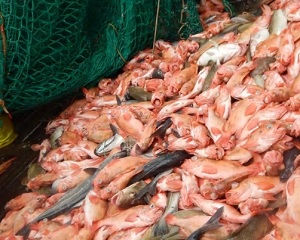 The Department of Fisheries and Oceans says the reopening of the redfish fishery in the Gulf of St. Lawrence could begin as early as June 15 and has announced the total allowable catch will be 60,000 tonnes for 2024-25. DFO announced the changes in a statement Friday. The department had said previously that the minimum allowable catch for the fishery would be 25,000 tonnes, but had not provided a cap. The commercial redfish fishery closed in 1995 over stock concerns. more, >>CLICK TO READ<< 13:26
The Department of Fisheries and Oceans says the reopening of the redfish fishery in the Gulf of St. Lawrence could begin as early as June 15 and has announced the total allowable catch will be 60,000 tonnes for 2024-25. DFO announced the changes in a statement Friday. The department had said previously that the minimum allowable catch for the fishery would be 25,000 tonnes, but had not provided a cap. The commercial redfish fishery closed in 1995 over stock concerns. more, >>CLICK TO READ<< 13:26

A Very Dire Situation: Downward spiral for Atlantic cod continues in Gulf of St. Lawrence
The latest assessment of Atlantic cod fish stocks in the Gulf of St. Lawrence continues to paint a bleak picture for the future of the species. Fisheries and Oceans Canada issued a warning five years ago saying extinction of the species in the gulf was not just possible, but probable. The first assessment since then has been released. “We are not seeing any recovery of the spawning stock biomass of that stock. It is still experiencing really high levels of natural mortality, especially at the adult stage of life,” said federal Fisheries and Oceans biologist Daniel Ricard. Between 60 and 70 per cent of cod in the southern gulf do not survive beyond age five and are likely being eaten by the huge herds of grey seals in the region, Ricard said. more, >>CLICK TO READ<< 11:17
Lobster dispute settled a day after fishermen defy order to remove traps
 A brewing battle between the federal government and lobster fishermen in northern New Brunswick appears to have come to an end. A federal closure of lobster fishing zones in the Gulf of St. Lawrence off New Brunswick’s Acadian Peninsula was being defied by hundreds of fishermen refusing to remove their traps. A news release from the Department of Fisheries and Oceans sent Thursday evening says that lobster boats will be able to fish closer to shore. “I am pleased to see DFO has adjusted the closure requirements and harvesters can now set their traps up to the 10 fathom shallow water protocol management line for the remainder of the 15-day period,” said federal Fisheries and Oceans , in the release. more, >>CLICK TO READ<< 08:50
A brewing battle between the federal government and lobster fishermen in northern New Brunswick appears to have come to an end. A federal closure of lobster fishing zones in the Gulf of St. Lawrence off New Brunswick’s Acadian Peninsula was being defied by hundreds of fishermen refusing to remove their traps. A news release from the Department of Fisheries and Oceans sent Thursday evening says that lobster boats will be able to fish closer to shore. “I am pleased to see DFO has adjusted the closure requirements and harvesters can now set their traps up to the 10 fathom shallow water protocol management line for the remainder of the 15-day period,” said federal Fisheries and Oceans , in the release. more, >>CLICK TO READ<< 08:50

N.B. lobster fishermen defy DFO, leave traps in despite closure for North Atlantic right whales
Several fishing zones in the area were officially shut down early by the Department of Fisheries and Oceans at 5 p.m. Wednesday because of a North Atlantic right whale sighting. But at a meeting in Lamèque at the time of the deadline, about 200 members of the Maritime Fishermen’s Union decided not to remove their roughly 60,000 traps in the area. However, the fishermen say they will not go out Thursday in order to give the federal agency one more chance to negotiate. On Wednesday, a release from DFO said that the fishing zone closures, initially scheduled to last 10 days, would stay closed for the rest of the season. more, >>CLICK TO READ<< 06:56
Acadie-Bathurst MP Serge Cormier says he can no longer defend his government on right whale protection issue
 A northeast New Brunswick Liberal MP is joining the Maritime Fishermen’s Union in calling for a better balance between protecting endangered North Atlantic right whales and allowing commercial fishing operations. Acadie-Bathurst MP Serge Cormier criticized his government for extensive closures of fishing zones that he warned could result in “disastrous consequences” and economic losses of $25 to 30 million. “While we are trying to save an endangered species, these extreme measures are actually endangering our fishing industry and coastal communities,” Cormier said in a statement released Thursday. “I can no longer defend my government on this issue. I stand with the fishermen, the lobster and crab industry, the factory owners and workers, and the community members.” more, >>CLICK TO READ<< 13:14
A northeast New Brunswick Liberal MP is joining the Maritime Fishermen’s Union in calling for a better balance between protecting endangered North Atlantic right whales and allowing commercial fishing operations. Acadie-Bathurst MP Serge Cormier criticized his government for extensive closures of fishing zones that he warned could result in “disastrous consequences” and economic losses of $25 to 30 million. “While we are trying to save an endangered species, these extreme measures are actually endangering our fishing industry and coastal communities,” Cormier said in a statement released Thursday. “I can no longer defend my government on this issue. I stand with the fishermen, the lobster and crab industry, the factory owners and workers, and the community members.” more, >>CLICK TO READ<< 13:14
Entangled North Atlantic right whale prompts fishing closure in Gulf of St. Lawrence
 Fisheries and Oceans Canada has temporarily shut down part of the Gulf of St. Lawrence to non-tended, fixed-gear fishing after an endangered North Atlantic right whale with gear entangled around its mouth was spotted northeast of New Brunswick Friday. The whale was seen northeast of the Acadian Peninsula and northwest of Quebec’s Magdalen Islands during routine aerial surveillance and was many nautical miles from land, Fisheries and Oceans Canada said in a news release Monday. It’s the first sighting of a North Atlantic right whale in Canadian waters this season, according to the release. more, >>CLICK TO READ<< 06: 56
Fisheries and Oceans Canada has temporarily shut down part of the Gulf of St. Lawrence to non-tended, fixed-gear fishing after an endangered North Atlantic right whale with gear entangled around its mouth was spotted northeast of New Brunswick Friday. The whale was seen northeast of the Acadian Peninsula and northwest of Quebec’s Magdalen Islands during routine aerial surveillance and was many nautical miles from land, Fisheries and Oceans Canada said in a news release Monday. It’s the first sighting of a North Atlantic right whale in Canadian waters this season, according to the release. more, >>CLICK TO READ<< 06: 56
Herring stock struggles continue
 Herring stocks in the south of the Gulf of St. Lawrence continues to struggle as the federal moratorium on spring herring fishing passes the two-year mark. Herring in Atlantic Canada is split into two stocks, corresponding with the breeding cycles of the fish. While spring herring stocks protected by the moratorium continue to struggle, fall herring can be fished sustainably and are not under a moratorium. Herring is an ideal species for bait and is a favourite for crustacean fishers. With spring herring stocks under moratorium, fishers in Atlantic Canada are forced to turn to alternative fish stocks. Mark Prevost, one of three co-owners of the alternative bait company Bait Masters, feels strongly about sustainability and shared concerns with SaltWire about the future of other fish stocks taking the brunt of the herring stock closure. more, >>CLICK TO READ<< 12:23
Herring stocks in the south of the Gulf of St. Lawrence continues to struggle as the federal moratorium on spring herring fishing passes the two-year mark. Herring in Atlantic Canada is split into two stocks, corresponding with the breeding cycles of the fish. While spring herring stocks protected by the moratorium continue to struggle, fall herring can be fished sustainably and are not under a moratorium. Herring is an ideal species for bait and is a favourite for crustacean fishers. With spring herring stocks under moratorium, fishers in Atlantic Canada are forced to turn to alternative fish stocks. Mark Prevost, one of three co-owners of the alternative bait company Bait Masters, feels strongly about sustainability and shared concerns with SaltWire about the future of other fish stocks taking the brunt of the herring stock closure. more, >>CLICK TO READ<< 12:23
From tiny river eggs to ocean prey, filmmaker aims to capture life of salmon
 As a child fly fishing on New Brunswick’s renowned Miramichi River, Nick Hawkins used to daydream about being able to peer under the tea-coloured water and see where the salmon were. Hawkins is one of nine winners of 2024 grants from the Trebek Initiative, named for the late quiz show host Alex Trebek. He’s getting $97,674 from two organizations that Trebek supported, the Royal Canadian Geographical Society and National Geographic Society, to film the migration of Atlantic salmon — “from their home rivers in Canada to their feeding grounds in the icy fjords of Greenland” — and to document “the passionate efforts of those trying to reverse the species’ precipitous decline.” Photos, more, >>CLICK TO READ<< 08:17
As a child fly fishing on New Brunswick’s renowned Miramichi River, Nick Hawkins used to daydream about being able to peer under the tea-coloured water and see where the salmon were. Hawkins is one of nine winners of 2024 grants from the Trebek Initiative, named for the late quiz show host Alex Trebek. He’s getting $97,674 from two organizations that Trebek supported, the Royal Canadian Geographical Society and National Geographic Society, to film the migration of Atlantic salmon — “from their home rivers in Canada to their feeding grounds in the icy fjords of Greenland” — and to document “the passionate efforts of those trying to reverse the species’ precipitous decline.” Photos, more, >>CLICK TO READ<< 08:17
P.E.I.’s snow crab season wrapping up as right whale protection begins
 An early start to the season is paying off for many P.E.I. snow crab fishers, with good catches and better prices than last year. An added bonus: for the second straight year, most will have caught their quota before endangered North Atlantic right whales move into the Gulf of St. Lawrence, prompting protective measures to prevent entanglement in fishing gear. Alden Gaudet said fishers are much better prepared this year than they were two years ago in case of closures due to right whales. “This year, we’ve lobbied to be able to immediately remove our buoys from these traps and use this ropeless, on-demand [system, without having to wait 48 hours to reset back in these areas. So it will make things a lot easier,” he said. Photos, Video, more, >>CLICK TO READ<< 07:42
An early start to the season is paying off for many P.E.I. snow crab fishers, with good catches and better prices than last year. An added bonus: for the second straight year, most will have caught their quota before endangered North Atlantic right whales move into the Gulf of St. Lawrence, prompting protective measures to prevent entanglement in fishing gear. Alden Gaudet said fishers are much better prepared this year than they were two years ago in case of closures due to right whales. “This year, we’ve lobbied to be able to immediately remove our buoys from these traps and use this ropeless, on-demand [system, without having to wait 48 hours to reset back in these areas. So it will make things a lot easier,” he said. Photos, Video, more, >>CLICK TO READ<< 07:42
Putting the Cart Before the Redfish
 This was supposed to be a good-news story. In Atlantic Canada’s Gulf of St. Lawrence, redfish have returned from the brink. Nearly 30 years after the fishery was closed, redfish populations have rebounded. Fishers, who have suffered through years of fisheries closures and widespread stock declines, have been eagerly eyeing the reemergence of the resource. But in early 2024, when Canadian fisheries minister Diane Lebouthillier declared that the redfish fishery would reopen later this year, keen observers received the announcement with apprehension. And now, as the reopening draws near—the tentative start date is June 15—conservationists and fishers say that climate change, shifts in the Gulf of St. Lawrence ecosystem, and unfavorable market conditions mean the fishery is unlikely to be the boon many are anticipating. This change of perspective hinges, in part, on research by scientists with Fisheries and Oceans Canada (DFO) that shows redfish have stopped growing. more, >>click to read<< 12:38
This was supposed to be a good-news story. In Atlantic Canada’s Gulf of St. Lawrence, redfish have returned from the brink. Nearly 30 years after the fishery was closed, redfish populations have rebounded. Fishers, who have suffered through years of fisheries closures and widespread stock declines, have been eagerly eyeing the reemergence of the resource. But in early 2024, when Canadian fisheries minister Diane Lebouthillier declared that the redfish fishery would reopen later this year, keen observers received the announcement with apprehension. And now, as the reopening draws near—the tentative start date is June 15—conservationists and fishers say that climate change, shifts in the Gulf of St. Lawrence ecosystem, and unfavorable market conditions mean the fishery is unlikely to be the boon many are anticipating. This change of perspective hinges, in part, on research by scientists with Fisheries and Oceans Canada (DFO) that shows redfish have stopped growing. more, >>click to read<< 12:38
No signs of herring stocks rebounding 2 years into moratorium, DFO says
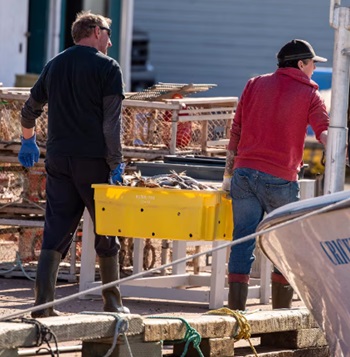 Two years into a moratorium on the East Coast’s spring herring fishery, biologists say the stock isn’t improving. Fisheries and Oceans Canada put a moratorium on fishing for herring in the Gulf of St. Lawrence, and on the mackerel fishery in Atlantic Canada and Quebec, on March 30, 2022. At the time, the department said urgent action had to be taken to give the stocks a chance to recover and to ensure the long-term sustainability and prosperity of East Coast fisheries. DFO biologist Laurie Maynard said that over the last two years of evaluation, the herring stock has plateaued at around 30,000 tonnes, but isn’t showing signs of growth. more, >>click to read<< 14:58
Two years into a moratorium on the East Coast’s spring herring fishery, biologists say the stock isn’t improving. Fisheries and Oceans Canada put a moratorium on fishing for herring in the Gulf of St. Lawrence, and on the mackerel fishery in Atlantic Canada and Quebec, on March 30, 2022. At the time, the department said urgent action had to be taken to give the stocks a chance to recover and to ensure the long-term sustainability and prosperity of East Coast fisheries. DFO biologist Laurie Maynard said that over the last two years of evaluation, the herring stock has plateaued at around 30,000 tonnes, but isn’t showing signs of growth. more, >>click to read<< 14:58
Talks continue on catch limits before moratorium lifts on East Coast redfish fishery
 The federal Fisheries Department (DFO), says it is still collecting feedback on how to reopen the redfish fishery this spring in the Gulf of St. Lawrence, after collapsing stocks led to a decades-long moratorium. The department says in a news release that it wrapped up four days of meetings with the industry-government redfish advisory committee in Halifax on Thursday. Participants included representatives from Indigenous groups, industry, provincial governments and environmental organizations. more, >>click to read<< 11:31
The federal Fisheries Department (DFO), says it is still collecting feedback on how to reopen the redfish fishery this spring in the Gulf of St. Lawrence, after collapsing stocks led to a decades-long moratorium. The department says in a news release that it wrapped up four days of meetings with the industry-government redfish advisory committee in Halifax on Thursday. Participants included representatives from Indigenous groups, industry, provincial governments and environmental organizations. more, >>click to read<< 11:31
Waiting for details on Gulf of St Lawrence redfish
 Canada’s Minister of Fisheries and Oceans Diane Lebouthillier last month announced a long-awaited decision on the reopening of the commercial redfish fishery in the Gulf of St. Lawrence, known as commercial redfish fishery. Now the Atlantic Groundfish Council and its members are awaiting more information on the decision to better understand the details. ‘During the consultation process, we were pleased to see various stakeholders sharing the view that the significance of historical shares and the investments by existing quota holders should be respected and are an important part of a sustainable and successful Canadian redfish fishery,’ said Sylvie Lapointe, President of the Atlantic Groundfish Council. more, >>click to read<< 07:08
Canada’s Minister of Fisheries and Oceans Diane Lebouthillier last month announced a long-awaited decision on the reopening of the commercial redfish fishery in the Gulf of St. Lawrence, known as commercial redfish fishery. Now the Atlantic Groundfish Council and its members are awaiting more information on the decision to better understand the details. ‘During the consultation process, we were pleased to see various stakeholders sharing the view that the significance of historical shares and the investments by existing quota holders should be respected and are an important part of a sustainable and successful Canadian redfish fishery,’ said Sylvie Lapointe, President of the Atlantic Groundfish Council. more, >>click to read<< 07:08
Gulf of St. Lawrence redfish population in decline even before fishery reopens, report finds
 The latest scientific assessment of the redfish population in the Gulf of St. Lawrence has sobering news even as fishing groups in Atlantic Canada and Quebec fight over who will get to catch it: their numbers are rapidly shrinking. “I think we’re at the point that we’re clearly seeing that there’s a limit to this boom,” says federal scientist Caroline Senay, the redfish specialist at the Department of Fisheries and Oceans (DFO). The report comes in advance of DFO’s plan to reopen the fishery later this year after it collapsed in the early 1990s and has been closed since 1995. more, >>click to read<< 09:20
The latest scientific assessment of the redfish population in the Gulf of St. Lawrence has sobering news even as fishing groups in Atlantic Canada and Quebec fight over who will get to catch it: their numbers are rapidly shrinking. “I think we’re at the point that we’re clearly seeing that there’s a limit to this boom,” says federal scientist Caroline Senay, the redfish specialist at the Department of Fisheries and Oceans (DFO). The report comes in advance of DFO’s plan to reopen the fishery later this year after it collapsed in the early 1990s and has been closed since 1995. more, >>click to read<< 09:20
Clearwater Seafoods loses redfish quota as other Indigenous harvesters gain
 Indigenous-owned Clearwater Seafoods is on the losing side of the redfish quota cut handed to the Atlantic Canadian offshore fleet by the federal government last week. The Department of Fisheries and Oceans reduced the share of Gulf of St. Lawrence redfish quota held by Clearwater and other offshore licence holders by 20 per cent, in part to encourage Indigenous participation in the fishery. Commercial harvesting will restart this year, marking an epic comeback from a collapse 30 years ago to a population now estimated at 2.2-million metric tonnes. Offshore companies spent tens of millions of dollars gearing up for the return only to lose a big piece of their quota on the eve of reopening. photos, more, <<click to read<< 14:11
Indigenous-owned Clearwater Seafoods is on the losing side of the redfish quota cut handed to the Atlantic Canadian offshore fleet by the federal government last week. The Department of Fisheries and Oceans reduced the share of Gulf of St. Lawrence redfish quota held by Clearwater and other offshore licence holders by 20 per cent, in part to encourage Indigenous participation in the fishery. Commercial harvesting will restart this year, marking an epic comeback from a collapse 30 years ago to a population now estimated at 2.2-million metric tonnes. Offshore companies spent tens of millions of dollars gearing up for the return only to lose a big piece of their quota on the eve of reopening. photos, more, <<click to read<< 14:11
Atlantic Groundfish Council Pleased With Redfish Allocation
 The shrimp biomass is declining significantly, and FFAW Secretary-Treasurer Jason Spingle fully expected DFO to give shrimpers access to a meaningful allocation of redfish. The year-round harvesters are generally pleased with the amount of redfish allocated to them. For the first time in decades, Ottawa is opening the redfish fishery in the Gulf of St. Lawrence. The Atlantic Groundfish Council says their sector lost 20 per cent of their historical share in the decision. Generally though, they praise DFO for resisting more drastic change in the total allowable catch. more, >>click to read<< 10:01
The shrimp biomass is declining significantly, and FFAW Secretary-Treasurer Jason Spingle fully expected DFO to give shrimpers access to a meaningful allocation of redfish. The year-round harvesters are generally pleased with the amount of redfish allocated to them. For the first time in decades, Ottawa is opening the redfish fishery in the Gulf of St. Lawrence. The Atlantic Groundfish Council says their sector lost 20 per cent of their historical share in the decision. Generally though, they praise DFO for resisting more drastic change in the total allowable catch. more, >>click to read<< 10:01
Group for Atlantic offshore redfish fleet says details scarce on fishery reopening
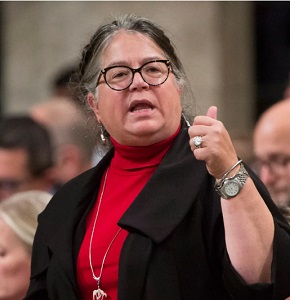 The organization representing Atlantic Canada’s offshore redfish fleet says it needs more details to better understand the ramifications of Ottawa’s lifting of a decades-long moratorium on the fishery. Fisheries Minister Diane Lebouthillier announced Friday that the moratorium put in place in 1995 would end this year, with an initial overall catch quota of at least 25,000 tonnes for the Gulf of St. Lawrence. Sylvie Lapointe, president of the Atlantic Groundfish Council, says the offshore fleet is facing a steep cut in its share of the fishery after being assigned 59 per cent of the 2024 quota. how the fishery will be managed. more, >>click to read<< 14:12
The organization representing Atlantic Canada’s offshore redfish fleet says it needs more details to better understand the ramifications of Ottawa’s lifting of a decades-long moratorium on the fishery. Fisheries Minister Diane Lebouthillier announced Friday that the moratorium put in place in 1995 would end this year, with an initial overall catch quota of at least 25,000 tonnes for the Gulf of St. Lawrence. Sylvie Lapointe, president of the Atlantic Groundfish Council, says the offshore fleet is facing a steep cut in its share of the fishery after being assigned 59 per cent of the 2024 quota. how the fishery will be managed. more, >>click to read<< 14:12
Ottawa revamps redfish allocation in Gulf of St. Lawrence, but N.S. keeps largest share
 Following months of anticipation and lobbying in Quebec, Newfoundland and Labrador, and Nova Scotia, the federal government has announced how it will allocate fishing access to the redfish population in the Gulf of St. Lawrence. The allocations were announced on Friday by Fisheries Minister Diane Lebouthillier at a news conference in Gaspé, Que. Under the new terms, Nova Scotia will continue to receive the largest portion of the allocation, but it appears the province has received in the past will decline. It is unclear by how much. more, >>click to read<< 15:55
Following months of anticipation and lobbying in Quebec, Newfoundland and Labrador, and Nova Scotia, the federal government has announced how it will allocate fishing access to the redfish population in the Gulf of St. Lawrence. The allocations were announced on Friday by Fisheries Minister Diane Lebouthillier at a news conference in Gaspé, Que. Under the new terms, Nova Scotia will continue to receive the largest portion of the allocation, but it appears the province has received in the past will decline. It is unclear by how much. more, >>click to read<< 15:55






